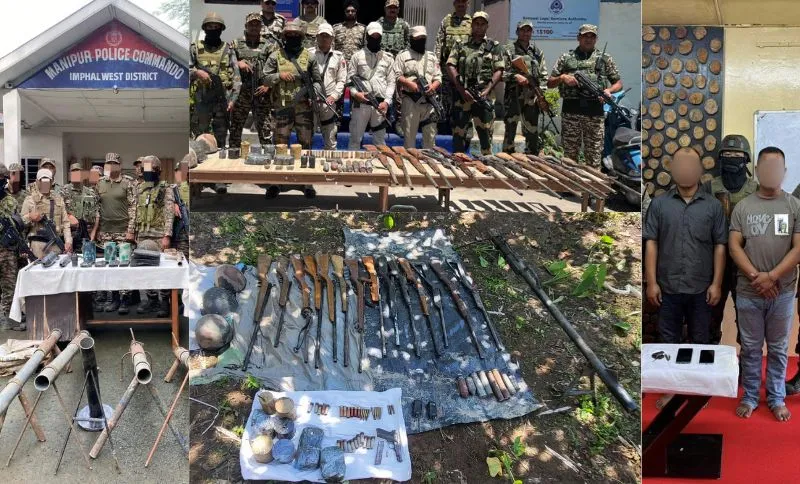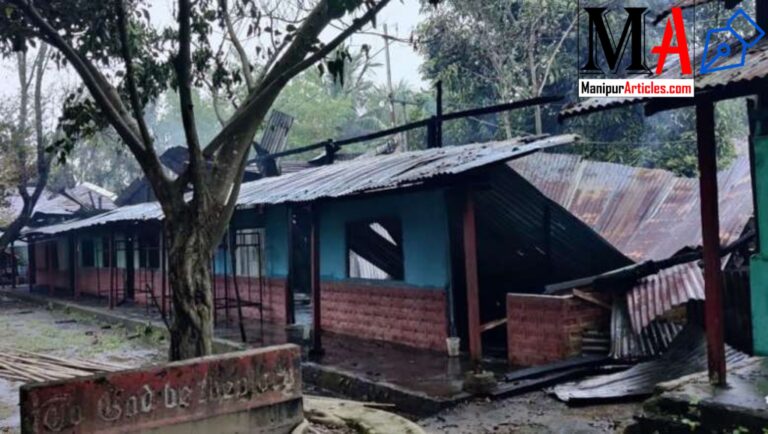MANIPUR SECURITY FORCES BUST INSURGENT RING: 15 CADRES ARRESTED, ARSENAL SEIZED
Short Summary
In a tightly coordinated crackdown between July 29 and August 4, 2025, Manipur’s security forces—including the Indian Army, Assam Rifles, Manipur Police, CRPF, BSF, and ITBP—arrested 15 active insurgent cadres across five districts (Bishnupur, Churachandpur, Thoubal, Imphal West, Imphal East) and recovered a huge cache of weapons and explosives. The haul comprised 69 firearms, 16 improvised explosive devices (IEDs), grenades, radio communication sets, bulletproof gear, and a heavy mortar. These operations, driven by precise intelligence inputs, aim to choke off militant supply lines and prevent a resurgence in violence
Setting the Stage—Insurgency’s Grip on Manipur
Imagine a land where every winding road holds a story of conflict and every hill whispers of hidden camps. Manipur, nestled in India’s northeast, has endured decades of separatist movements, ethnic clashes, and cross-border smuggling. While news headlines often spotlight peak crises, beneath the surface there’s a simmering cat-and-mouse game between insurgents and security forces.
The recent joint operations—spanning five districts over a week—weren’t an isolated raid but the crescendo of months of surveillance, informant networks, and data analysis. When multiple agencies synchronize like a Swiss watch, you know something big is brewing.
Who Are These Insurgent Cadres?
Most of the arrested individuals were active fighters from various valley- and hill-based outfits. While official releases haven’t named all the groups, Manipur has long grappled with factions such as PREPAK (People’s Revolutionary Party of Kangleipak), PLA (People’s Liberation Army), and KCP-PWG (Kangleipak Communist Party-People’s War Group). These outfits have thrived on a toxic cocktail of ideology, ethnic grievances, and illicit funding.
For the layperson, it helps to think of Manipur’s insurgency like a sprawling forest: different trees (groups) growing roots independently yet interconnected by underground water streams (arms channels, recruitment networks). Uprooting one sapling doesn’t collapse the grove—but a well-coordinated strike across multiple groves can start tipping the balance.
Anatomy of the Crackdown—July 29 to August 4
Intelligence Gathering—Connecting the Dots
Every successful operation begins with actionable intel. Over the past few months, Manipur’s Defence Wing and intelligence agencies intercepted suspicious communications routed through handheld radios and burner phones. Information trickled in from local informants—shopkeepers, taxi drivers, even sympathetic villagers—painting a picture of imminent arms movements.
Picture investigators like puzzle solvers: each intercepted message, reconnaissance drone image, or anonymous tip is a piece. Slowly but surely, they completed the map, highlighting five “vulnerable locations” across Bishnupur, Churachandpur, Thoubal, Imphal West, and Imphal East
Multi-Agency Coordination—A Force Multiplied
Once the pattern emerged, the Indian Army, Assam Rifles, Manipur Police, CRPF, BSF, and ITBP formed a joint task force. It’s akin to assembling the Avengers—each brings unique strengths:
- Army & Assam Rifles: Jungle warfare, heavy-weapons expertise.
- Manipur Police: Local knowledge, community ties.
- CRPF & BSF: Rapid-response teams, specialized riot-control units.
- ITBP: Border patrol, high-altitude operations.
This fusion ensured simultaneous raids, preventing suspects from slipping through administrative cracks.
The Raids—From Dawn to Dusk
Between July 29 and August 4, squads fanned out at pre-dawn hours—when insurgents are most vulnerable. In Churachandpur’s dense forests, Commandos surrounded suspected hideouts; in Thoubal’s peri-urban areas, undercover teams trailed foot soldiers to stash points. At each location, the mantra was “speed and surprise.” When doors burst open, suspects were caught off-guard, minimizing firefights and civilian risk.
The Arsenal—69 Weapons, 16 IEDs, and More
When security forces lifted the dust from hidden caches, the scale of the haul resembled an illicit armory rather than a backyard shed.
- Firearms (69 total): A mix of self-loading rifles (SLRs), AK-series assault rifles, pistols, and pump-action shotguns.
- Improvised Explosive Devices (16): From crudely fashioned pipe bombs to sophisticated IEDs with remote triggers.
- Grenades & Heavy Mortar: Several fragmentation grenades and a modified heavy mortar capable of targeting fortified structures.
- Communication Gear: Encrypted radios, satellite phones, and a field-deployable repeater—tools to evade standard jamming.
- Protective Gear: Bulletproof jackets and helmets, underscoring the militants’ anticipation of armed clashes.
- Logistical Items: Maps with coded routes, ration packs, and medical kits, hinting at well-established jungle circuits
It’s like discovering a pirate’s buried treasure—but instead of gold doubloons, you find instruments of death.
FAQs
- Which districts saw the arrests and seizures?
Operations spanned Bishnupur, Churachandpur, Thoubal, Imphal West, and Imphal East districts - How many weapons were recovered?
A staggering 69 firearms—including assault rifles, SLRs, and pistols—and 16 IEDs were seized - What agencies participated in the raids?
The crackdown involved the Indian Army, Assam Rifles, Manipur Police, CRPF, BSF, and ITBP, operating under HQ IGAR (South). - Under which laws are the suspects being prosecuted?
Charges include the Arms Act, Explosives Act, and relevant provisions of the UAPA, carrying penalties up to life imprisonment and hefty fines. - What measures are in place to prevent insurgent reprisals?
Authorities have set up village defense committees, bolstered night patrols, and established citizen hotlines to quickly report suspicious activity.




